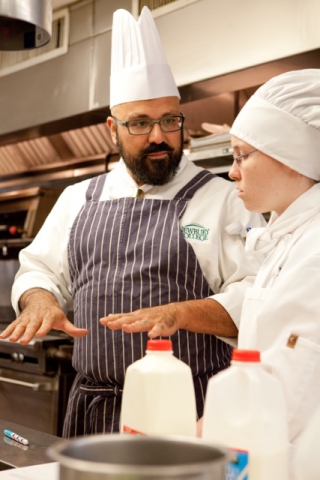
Teaching From “Things” to “Ideas”
03 October 2018Providing students with a space to teach themselves to learn is key to lifelong learning and an engaged classroom.
By Chef David Pazmiño of Newbury College
A few years ago, I had the pleasure of taking master classes with Chef Fritz Sonnenschmidt both in New Orleans and Chicago. During one of his keynote speeches, he gave the following statement paraphrasing the famous quote from Eleanor Roosevelt:
Stupid people talk about other people.
Interesting people talk about things.
Brilliant people talk about ideas.
Since then, I have been using this quote as part of my syllabi, discussions on professionalism, and as a guiding force for my own teaching. I have printed out this quote and put it around the various kitchens where I have taught, and often find myself asking students what “type of person are you being today?”
While this has served to diffuse budding tensions in the class (especially during cleanup time, because as I tell my students none of them want to be stupid), I think that Chef Fritz’s lasting legacy is how to teach our students to be both “interesting” and “brilliant.” And this is no easy task.
Students decide to enter the baking and pastry field for a myriad of reasons: a love for baking, a desire to decorate cakes, and the all too familiar response, “I love watching Cake Boss.” Yet despite this budding interest in the baking and pastry profession, it is often hard for them to cultivate their passion in a way that makes them both interesting and brilliant. Of course, there are students that display this desire to talk about “things” and “ideas”, but for many students this is a struggle. For some, they don’t yet have the confidence to talk in front of groups. For others, they don’t feel like they have a proficiency of language skills to effectively communicate their thoughts, and for others, they might be in a learning situation where processing information to retain it as knowledge is what they can currently achieve successfully.
Finding ways to target each of these groups simultaneously and embrace the concept of talking about “things” and “ideas” dovetails with the current educational model that emphasizes critical thinking as fundamental to lifelong learning. And if you look at the lifelong learners of our profession, the chefs and pastry chefs, what is it that sets them apart from others that are simply craftsmen of their trade but not pushing the culinary envelope?
Most of these chefs are highly curious, seeking out answers to their questions, and having no fear when they make mistakes. But what they do is actively learn from those mistakes, altering their initial habits to get different results. This is critical thinking. Using a tool learned from Dr. Fred Mayo, author of Gold Medal Classroom’s Mayo’s Clinic, during an inservice workshop when I worked for the now defunct Center for Culinary Arts, I used to end many of my classes with the “whip”: What did you learn today? Altering this, I now ask, “What mistake did you make today and what would you do differently?” It is amazing to see all the students are able to process almost instantaneously what they did wrong and how to improve on it the next time. Their own innate powers of observation are right there, they just have to learn how to tap into them.
During long production classes of 6 hours, one of the more frequent questions most culinary instructors often hear is, “Why can’t we play music?” It really isn’t music that they seek, rather a distraction from a repetitive task. While there are studies that both say that background music can both improve and distract from work, why not offer engaging prompts that encourage discussion? One thing that I will often do is create a QR code linking to a different website for the food sections of major newspapers. During the first 10 minutes of class, each group (I run my bakeshop kitchens as rotating stations) has to look through the headlines of the Wednesday food section and pick an article to talk about among themselves. At appropriate times during class, I also have the groups share amongst themselves. This simple task really teaches them what most chefs are already doing, reading the Wednesday Food Section of some of the more prominent major newspapers and discussing it with their family, friends, and colleagues. It also helps build confidence in many of my culinary students because they are able to talk in smaller groups more easily which bolsters their ability to talk to the whole class. Furthermore, they are talking about “ideas” and “things.”
Moving students to be “interesting” and “brilliant” just takes creative thinking to develop a classroom where students are able to talk about “things” and “ideas.” Giving them space to learn how to teach themselves to learn is really the key to not only lifelong learning but an engaged classroom in which all students can participate.
